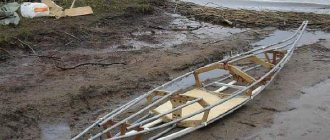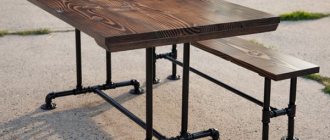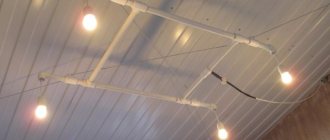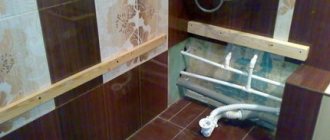Throughout the Russian climate, frequent precipitation is far from uncommon. And therefore, it is customary to install a drain in homes that controls and removes these precipitation away from the roof itself. If a house stands for a long time without a drainage system, its base, facade and walls are destroyed. There are also longer-term consequences: a flooded basement, washed-out land around the house and other problems. That's why there should always be a drain!
But if you have just purchased a house or cottage and have a limited budget, you can temporarily make a drain from sewer pipes with your own hands: it is not difficult, and in practice such a system will be reliable. But for such small buildings as a gazebo, a children's house in the garden or a canopy over a car, a homemade drain is quite suitable as the main one. And we will teach you how to do everything right!
Drainage system project
Like any communication, the drainage system begins with drawing up a project. First you need to determine the type of drainage system and the choice of material for the pipes. After this, you can start making calculations.
Type of drain
There are two types of gutter systems, depending on the type of roof you have. The vast majority of houses are built with a sloping roof, since a flat roof is not suitable for our winter and snow. Gutters and pipes are hung from the outside of the building. Next we will talk specifically about external storm drainage.
The internal drain is mounted on a flat roof. The water collection system here is different. It is designed with a slight slope to collect water, which acts as a kind of gutter. The storm drain begins at this point and consists of vertical pipes embedded in the wall with a funnel on the roof where precipitation is collected.
Pipe material
Plastic pipes for sewerage are made from polyvinyl chloride (PVC) and polypropylene. PVC pipes are not suitable for external storm drainage. This material is designed for underground installation. The sun's rays and temperature changes have a destructive effect on it.
Polypropylene pipes are available in three types: white, gray and brown. The variety of colors does not show the aesthetic preferences of manufacturers, but corresponds to certain operational parameters:
- Residents of the southern regions can choose white and gray sewer pipes made of polypropylene for DIY drainage installation. They are intended for indoor installation and do not tolerate negative temperatures. The structure of the polymer is also disrupted when there is a significant difference.
- Brown pipe materials have a thicker wall and are intended for external installation. They are resistant to frost, but do not tolerate high temperatures. This is a good material for installing external drainage in central and northern regions.
The fittings, connection principle, and dimensional characteristics of pipes of different colors are the same.
Calculations and dimensions
To make the calculations correctly, you will need to know:
- roof perimeter length;
- height of the house;
- number of vertical risers;
- number of gutter connections;
- number of plugs, corners and tees;
- number of fastenings.
Additionally, you need to determine the desired diameter of the pipes for gutters and for vertical receivers. A classic drain is made from sewer pipes with a diameter of 110 mm (gutters) and 50-80 mm (racks). This is enough for the safe collection and disposal of water during intense rains. The total length of the gutters is calculated along the perimeter.
After calculating the length of the pipes for the gutters, it should be divided in half. From one meter of pipe you will get two meters of gutter.
The number of vertical pipes corresponds to the number of risers multiplied by the height of the house to the edge of the roof. Here you need to draw the pipe configuration and measure everything in place.
The vertical pipe will go from the roof slope not straight down, but through an S-shaped bend to the wall of the house. It will need to be attached to the wall, not leaning against it, but at a distance of 10 cm from it.
To install the bend, you will need a 45-degree elbow, plus one corner to drain water away from the house.
Fittings will be needed to plug gutters in the corners of the house and to install a drain funnel. You need to take a plug for a pipe with a cross-sectional size of 110 mm. The funnel will require a 110 mm adapter tee with a 50 mm outlet. The number of tees is also determined by vertical drains.
The gutters are connected using couplings. Their number is 1 less than the number of gutters themselves.
The number of horizontal fastenings is calculated based on the installation every 50-60 cm. The distance is recommended by experts based on the weight of the structure at its maximum load. With a pitch of 60 cm, 17 fastenings will be required per 10 m of roofing. Vertical pipes are secured with clamps every 1.5 m.
What kind of water interferes with the life of a developer and a country homeowner?
A whole book could be written about the types of surface and ground water, as well as drainage and storm sewer systems. Therefore, we will leave beyond the scope of this article a detailed listing of the types and causes of groundwater occurrence, and will concentrate on practice. But without minimal theoretical knowledge, starting to independently arrange drainage and storm sewer systems is throwing money away.
The fact is that even an incorrectly designed drainage system functions for the first few years . Then, due to clogging (siltation) of the drainage pipe, wrapped in geotextile, which was placed in clayey, loamy, etc. soil, drainage stops working. But money has already been spent on drainage construction and, most importantly, drainage construction involves a large amount of excavation work involving equipment.
Therefore, simply digging up and relaying a drainage pipe 3-5 years after it was laid is difficult and costly. The site has already been inhabited, landscaping has been done, a blind area has been arranged, a gazebo, a bathhouse, etc. have been installed.
You will have to rack your brains on how to redo the drainage so as not to ruin the entire area.
Hence, the construction of drainage should always be based on data from a geological study of the soil (which will help to find a waterproof layer in the form of clay at a depth of 1.5-2 m), hydrogeological surveys and clear knowledge of what kind of water leads to flooding of a house or waterlogging of an area.
Surface waters are seasonal in nature, associated with the period of snowmelt and abundance of rain. Groundwater is divided into three main groups:
- Capillary water.
- Ground water.
- Verkhovodka.
Moreover, if surface water is not drained in time, it turns into underground water when infiltrated (absorbed) into the ground.
The volume of surface water usually exceeds the volume of groundwater.
Conclusion: surface runoff should be drained away by storm (rain) sewerage, and not try to create surface drainage!
Storm drainage is a system consisting of trays, pipes or ditches dug in the ground, discharging water from drains outside the site + competent organization of the relief on the personal territory. This will allow you to avoid stagnant zones on the site (lenses, pools), where water will accumulate, which simply has nowhere to go, and further waterlogging.
The main mistakes that are made when installing drainage yourself:
- Failure to maintain the correct slope of laid drainage pipes. If we take an average, then the slope is maintained in the range from 0.005 to 0.007, i.e. 5-7 mm per 1 running meter of drainage pipe.
- Using a drainage pipe in a geotextile wrap on “wrong” soil. To avoid siltation, pipes in geotextiles are used on soils consisting of clean medium- and coarse-grained sands.
- Using cheaper crushed limestone instead of granite, which is washed away by water over time.
- Saving on high-quality geotextiles, which must have certain hydraulic properties that affect the quality of drainage. This is an effective pore size of 175 microns, i.e. 0.175 mm, as well as transverse Kf, which should be at least 300 m/day (with a single pressure gradient).
Do-it-yourself manufacturing and installation technology
The easiest and simplest way to install a drainage system is to install it yourself on the front board. Such a board is pre-fixed on the facade of the house under the roof overhang. After installing the frontal board with your own hands is completed, you can begin to manufacture and install a storm drain from sewer pipes.
Manufacturing of gutters
One of the main aspects of installing a drainage system is the manufacture of gutters from sewer pipes. To do this, you must follow these instructions
- You need to cut the plastic blank in half.
- This can be done with a circular saw or a hand hacksaw.
- Thus, two gutters are obtained from one pipe.
- The cut must be carefully processed with sandpaper or a file in order to remove burrs.
- To make the seam as even as possible, you first need to make a marking - draw a cutting line with a marker.
Bracket installation
Mounting brackets are required to install gutters. There are two options available here:
- Purchase ready-made plastic brackets of the appropriate size.
- Make your own brackets from sheet metal. Galvanized or stainless steel works well, as does thick aluminum.
It is best to install the brackets on a frontal board, the installation of which on the façade of the house must be done in advance. The brackets are fastened with ordinary self-tapping screws.
It is important to maintain a slight slope to the corners of the house where the funnels will be located
Installation of a drainage system
After all the preparatory work has been completed, you can begin installing the drainage system. This must be done in the following sequence:
- The gutters are connected to each other using sealant to provide a waterproof seam. The rubber bands included in the sewer system kit do not need to be used.
- To ensure mechanical strength of the connection, it is recommended to use aluminum clips.
- The unsawed edges of the gutters are inserted into the tee, which acts as a funnel, in the usual way: using sealing gum and sealant.
- The ends of the outer gutters must be closed with a plug.
- Vertical risers of the drainage system are attached to the facade of the house using special clamps.
- The joining of gutters and risers is done through elbows with a suitable bending angle.
As you can see, it is quite simple to assemble a drainage system from sewer pipes with your own hands. To do this, you will need a minimum of knowledge and tools that any owner who prefers to do all the work themselves has.
Water drainage elements
Before installing the drain, you need to study all the components that will be required for the work, namely:
- gutter, the main component of drainage. You can buy it ready-made, or get it by sawing the pipe in half;
- bracket, special mount for drainage;
- branch A vertically installed pipe for draining rainwater from the drainage system;
- funnel. A kind of adapter from the upper part of the drain to the outlet;
- stub. Used for dead-end drainage elements;
- corners. Angle adapter. Purchased according to the number of corners on your roof;
- coupling The connecting part of the gutter, which is used for joining;
- fastener As a standard, a self-tapping screw or a self-tapping screw with a nut is used. The presence of a rubber gasket in the fastener is mandatory.
We looked at the main elements used in water drainage. Depending on the design and material used, their number can be added or decreased.
Purpose of storm drainage
Sediment drainage systems are gutters and pipes connected in a certain way. They encircle the building along the perimeter of the roof and go down in several places. Next, the water is sent either to the central sewer system, city storm drains, or to storage tanks to collect precipitation.
Main purpose of the drain:
- protection of walls, foundations and basements from getting wet and flooding;
- protecting the site from erosion, and the local area from dirt and puddles.
An additional purpose, important for gardeners, is the accumulation of free rainwater for irrigation and other household needs. A bonus includes clean walls, windows and the basement of the house, which is also important.
Installation of gutters and PVC pipes
In order for the drainage system to perform its functions efficiently, it must be properly installed. Naturally, before this, the building must have a rafter frame and sheathing protected by waterproofing material.
Installation of a plastic drainage system is as follows:
- First, you need to mark the gutter attachment points on the front board so that the slope is from 3 to 5 degrees per meter of drainage (to maintain the slope, you should use a cord);
- Next, the brackets are attached, and they need to be installed so that the overhang of the slope is exactly in the middle of the gutter - this placement will protect the drainage system from snow;
- The installation process must be started from the point where the funnel will be located, measuring 15 cm in each direction and installing brackets at the resulting points;
- All brackets, except the first ones, are installed in increments of about 50 cm, and installation is carried out towards the funnel;
- A funnel is installed on the brackets, after which you can begin installing the gutter, having previously adjusted it to the required dimensions;
- When installing the gutter, it is necessary to use sealant or rubber connecting elements;
- The brackets necessary for fixing the drain pipe are attached to the wall vertically in increments of one meter;
- Next, a drain pipe is mounted, which must first be attached to the funnel, adding the necessary part with separate parts of pipes fastened with couplings;
- The lower part of the drain is equipped with a curved tip, the edge of which should be located at a distance of no more than 30 cm from the ground.
Device and equipment
For the production of plastic gutters, polyvinyl chloride is used - a polymer material obtained by thermoplastic processing. All components of drainage systems are made from this material.
Installation of plastic gutters is carried out using the following elements:
- Gutters. These elements are necessary to receive and transmit water flowing from the roof slopes to the water intake funnel. Plastic gutters differ from metal products in a wide variety of sizes, which allows you to choose the best option for a particular situation.
- Gutter coupling. The coupling allows you to connect individual parts of the gutter. This element is small in size, and its installation requires silicone sealant or a rubber gasket.
- Corner. The angles allow you to direct the plastic gutter in the desired direction. In construction, parts with a right bend angle are most often used, but if it is necessary to create a different angle, a non-standard option can be found on the market.
- Brackets. These elements are fasteners that support the gutter. The holders themselves are attached to the sheathing boards.
- Plugs. These parts of the drainage system allow you to block water from accessing the drain through the edge of the gutter, located on the other side of the funnel.
- Water intake funnel. This is an essential element of any drainage system, which collects water from the gutter and transfers it to the drain pipe. Visually, this part is a small trench that turns into a funnel.
- A drain pipe. This pipe is installed vertically and ensures that the liquid collected by the funnel is transferred to the storm drain.
- Drain pipe end. This element of the drainage system is necessary so that the flowing water slows down as it drains. The tip has a curved shape, due to which the speed of liquid movement is dampened.
- Brackets for drain pipe. The brackets are attached to the wall of the building at a certain pitch, after which a pipe is inserted into their outer rings.
When choosing plastic drainage elements, you need to remember that there are no strict standards regarding the size of parts. To ensure that plastic drainage pipes are compatible, it is worth purchasing a complete set from one manufacturer.
Drainage equipment
The drainage system is a single structure, the elements of which are designed to collect, pass and accumulate excess water. If you exclude even one structural element, drainage will worsen and gradually disappear.
What does the system consist of?:
- Drains with a diameter of 100–180 mm;
- Inspection/drainage wells (240–360 mm);
- Absorption well (may not exist);
- The collector, the final link of the chain. This is where the water coming from all the pipes in the area accumulates.
What pipe color to choose
There are two types of drainage systems: internal - for flat roofs and external - for sloping roofs. Accordingly, pipes are used for internal or external drainage. Sewer pipes are produced by manufacturers in various colors. This is done to make it easier for customers to navigate among them. Thus, sewer pipes are gray, white and brown.
Gray pipes
They are the most popular and widespread. Manufacturers recommend using them for organizing internal communications. The composition of the material used to make these pipes is designed for operation in positive conditions, so such pipes can withstand high temperatures, but are very sensitive to negative ones. In addition, these pipes are less adapted to physical stress.
The use of gray pipes when organizing drainage is possible in regions with a mild climate that are not characterized by harsh winters. Such pipes are susceptible to mechanical stress, so their gutters should be regularly cleared of accumulated snow.
White pipes
Like the gray ones, these pipes are designed for installing sewer systems inside the house. Their distinctive feature is that they are able to withstand very high temperature loads, and also perfectly absorb the sound of flowing water. Otherwise, such pipes are no different from gray ones.
A drain made of white plastic pipes will serve for a long time in regions with mild winters, however, such pipes are not ready for high negative loads, as well as sudden temperature changes.
Red pipes
These pipes are intended for installation of external sewer systems. Their fundamental difference from gray and white pipes is their thicker wall. The material from which these pipes are made is resistant to negative temperatures and high pressure, but is sensitive to high temperatures.
Drainage systems made from red pipes are ideal for regions with harsh winters with sudden temperature changes. Ways to withstand high loads in the form of snow and ice. In the south, it is not recommended to make water outlets out of them, since exposure to the scorching sun can make them fragile.
Step-by-step instruction
Installation of gutters consists of two important stages:
- installation of gutters;
- strengthening vertical risers (on average, one riser is installed for every 5 meters of gutters).
Before purchasing building materials, it is necessary to sketch out a schematic plan of the entire system, taking into account the technical requirements:
- distance between risers;
- the number of tees (it directly depends on the number of risers);
- number of clamps and brackets.
The gutters are assembled in the following order:
- Pipes with a diameter of 11 centimeters are cut. For work, a hacksaw blade, electric jigsaw or grinder is used. A long ruler is attached to the pipe using tape to serve as a guide!
- To ensure maximum structural strength, it is necessary to leave the areas in front of the risers uncut. This is approximately 15-20 centimeters on both sides of the riser.
- The brackets are secured using screws and a screwdriver. This is done in three ways - on the front board, roof sheathing or rafters.
- Fastening to the sheathing can only be done during roof construction. The remaining two options allow installation without dismantling the roof at any time convenient for the owners. It is recommended to use industrial brackets that are ready for assembly. To save money, you can also use homemade elements made of sheet metal (tin).
- The location points of the brackets are determined using a construction cord - the system should have a slight slope towards the drain (about 1 cm per linear meter).
- The gutters are glued together or ready-made aluminum clips are used. All joints are lubricated with sealant!
- With the help of transition pipes, the gutters are led into tees.
- A plug is installed at the top point of the gutter.
If installation of drains is required, additional work is carried out:
- The pipes are attached to the wall from bottom to top. Clamps are used as fastenings. The recommended distance from the wall is 10 centimeters.
- The top of the pipe is connected to the tee. The tightness of the joints is ensured using a universal sealant.
- The lower part of the wastewater is discharged into a storm sewer, or a special elbow is installed to drain moisture into a special container for collecting water.
At the final stage, it is necessary to protect the drainage system from large debris. To do this, the plastic mesh is cut into pieces, from which rolls are rolled. The coarse mesh is fixed with plastic clamps and placed in the gutters - the rolls successfully replace an industrial filter.
Basic selection options
Sewer pipes are a practical building material, very easy to assemble. The assortment of hardware stores includes all kinds of adapters and sockets - it will be very easy for the owners to select all the structural elements necessary for the work. And the finished gutter can be easily painted in a color that ideally matches the façade of the building.
To avoid confusion with calculating the exact amount of precipitation in a particular area, you can purchase pipes using average parameters. The only thing that is required from the owners is to measure the perimeter of the entire roof and the height of the building in order to determine the length of the drain.
It is necessary to take into account that each section of pipe will be divided in half into two separate parts. This means that in the end, you should purchase half as many pipes.
Average pipe sizes suitable for most regions in temperate climates:
- For drainage (vertical structures), pipes with a diameter of 5 centimeters are required. There is no need to cut them, they are installed whole.
- Plastic pipes with a diameter of 11 centimeters are suitable for arranging gutters. They can be safely cut in half - precipitation will be discharged quickly enough and without loss (leakage onto the walls and foundation).
In addition to the set of pipes, tees are purchased to facilitate installation of the entire structure.
We buy materials for drainage
So, the first thing that needs to be done is to purchase the required number of plastic pipes, as well as additional elements for the drainage system, and these are fittings, clamps, brackets, and so on. Although, if the conversation is about how to make a drain with your own hands, then we will try not to buy anything other than pipes and fittings, but to make everything from scrap materials.
You need to make a rough calculation of the number of pipes. They will be used to make gutters installed under the eaves of the house, and the actual pipes for the drain risers. As for gutters, their number is determined by the length of the cornices. And since each plastic pipe will be cut into two parts (the cut will be made lengthwise), the number of pipes for gutters is halved. Of course, you will have to take into account not the length of the pipes itself, but the segment without sockets.
This means that you need to measure the length of the eaves, divide this indicator by two, and you get the total length of the gutters. This value must now be divided by the length of one pipe, which has a maximum size of 6 m.
As for the pipes of the drain risers, there is no need to cut them; they are installed into each other using a socket connection system, where a rubber cuff (seal) is used. Their number will depend on two indicators:
- height of the walls of the house;
- number of drain risers.
The height will have to be measured with a tape measure from the ground surface to the cornice. It is necessary to subtract 25 cm from this value - this is the standard recommended distance from the drain to the ground. Now the result obtained is multiplied by the number of risers. How to determine how many risers should be in the drainage system of a house. Here, first of all, the area of the roofing system slopes is taken into account. The larger the area, the more water will flow into the drain. And this volume will need to be discharged by the number of risers. The minimum distance between them is 5 m. But if the house is small, then installation is carried out in the corners of the building. For example, if this is a house with a gable roof, then four risers will be enough.
Now regarding the diameter of plastic pipes. There is a certain relationship between the diameter and area of the slopes. Look at the table.
| Roof slope area, m² | Pipe diameter, mm |
| Up to 50 | 100 |
| 50-100 | 150 |
| Over 100 | 200 |
As practice shows, the optimal choice is the second position. You can't go wrong.
So, the number of plastic pipes for the drainage system has been determined, their sizes have been selected, and procurement can be carried out. But before that, let's decide on the number of fittings. As for the elbows (bends), much will depend on how the roof overhang is located and whether there are decorative elements after it. Therefore, there will be either two or four bends in this area. Let's add drain bends here, it is better to use them with an angle of 45°, they are also called half-bends. Do not forget about the knees in the tray system; they are usually installed at the corners of the building if it has a multi-slope roof, for example, a hip roof.
Expansion elements, which are included in the category of fittings, can be used as funnels in this drainage structure. They are usually called adapters, but it is better to purchase ready-made funnels for drains. They cost pennies, so you can splurge on them. Their number is equal to the number of vertical pipe risers.
Classification
A drainpipe can be classified according to the following criteria:
- According to the material of manufacture;
- To size;
- According to the sectional shape.
There are a number of other signs, but these are the main ones.
So, based on the first sign, we can distinguish elements such as plastic and metal. Metal ones are divided into galvanized steel, polymer-coated steel and copper with zinc-titanium coating. If we consider in more detail, we can distinguish the following varieties:
- Based on galvanized steel;
- Based on galvanized steel with a polymer coating (on one side) with a thickness of 25 to 50 micrometers;
- Based on galvanized steel with a polymer coating (on both sides) with a thickness of 100 to 200 micrometers;
- Copper or titanozinc.
According to their shape, sections are divided into round and rectangular. There are also specially shaped products.
Drainpipe made of various materials
As for sizes, you need to consider steel or copper materials separately from plastic products.
How to make your own fasteners
Now we move on to the fastening part of the house's drainage system. There are two varieties:
- brackets for gutters;
- and brackets for drain pipes.
The first can be made from a metal strip 2-3 mm thick and 20-30 mm wide or from wire with a diameter of 4-5 mm. You just need to bend the metal profile to the required size and shape. Approximately the same as shown in the figure below. The shank of the bracket can be bent or be as shown in the photo, all this will depend on how it will be attached to the load-bearing element of the roof.
As for brackets with a clamp for riser pipes, it is more difficult to make it yourself, so here’s some advice:
Advice! Buy clamps at a hardware store; they are cheaper than funnels. In addition, you can choose them by color so that it matches the color of the pipes.
This is interesting: How to make a tool box with your own hands (video)
Installation of a drainage system
To understand how to make a drain from sewer pipes, it is important to take into account some installation features. Perimeter gutters can be installed:
Perimeter gutters can be installed:
- to the edge of the rafter system,
- on the front strip of the cornice,
- on the roof itself.
The first two options are preferable, but they are easy to implement if the drain from sewer pipes is installed with your own hands at the construction stage, that is, before laying the top layer of the roof.
Mounting option for drainage brackets
- If the system is installed in an already built house, installation on the edge of the roof is allowed. It is advisable to choose the same method if the roof overhang is large (the edge is located at a considerable distance from the wall of the house).
- The gutters are installed in such a way that they extend beyond the edge of the roof by a third of the diameter of the pipe section and protrude by two-thirds, “catching the flow of water.”
- To ensure that water does not stagnate in the gutters, they should be placed with a slight slope towards the funnel (2-5 mm for each meter of length). The easiest way is to calculate the total slope along the side, mark the starting and ending points, and then connect them, marking the installation locations of the brackets. This will ensure a uniform slope.
- The upper edge of the gutter must be at least 3 cm below the level of the edge of the roof. Otherwise, the structure could be torn off by snow or ice moving from the roof in the spring.
Having familiarized yourself with these nuances, you can begin to install a drain from the roof from sewer pipes.
For this you will need:
- screws, screwdriver or screwdriver;
- level and tape measure;
- file, sandpaper;
- hacksaw or grinder;
- twine;
- ladder or scaffolding.
Stage 1 of work
Pipes intended for the manufacture of gutters are sawn in half in the longitudinal direction. To improve accuracy, you can use a wooden template. It is better to lightly sand the edges (cutting areas). When making cuts, check the drawn diagram - at the joints you need to leave solid sections as connecting pipes for fittings.
A plastic fitting acts as a drain funnel, to which gutters are connected horizontally, and pipes with a diameter of 50 mm are connected vertically
Stage 2
Installation of brackets begins from the extreme positions. The corner elements are attached using threaded hardware, after which a string is stretched between them to check the slope. Intermediate holders are fixed along the intended line between the extreme positions with an interval of 500-600 mm.
In the same way, only without a slope, fixation points are marked and clamps are installed for vertical pipes for drainage. It should be borne in mind that such risers should not lie flush against the wall. The distance should be about 5-10 cm.
Stage 3
Gutters from sewer pipes are installed. The elements are connected using special glue or aluminum clips. In the second case, it is necessary to use a sealant to create an impenetrable joint. The plugs are installed in the same way.
The exception in terms of assembly method is funnels. This is the only element of the system that is installed using a glueless method. To seal the joint, rubber gaskets are used, which are found in plastic fittings (tees). Such sections of the structure are assembled in the same way as sewer pipes, into a socket.
Stage 4
1 - plastic gutter, 2 - bracket, 3 - fitting, 4 - plug, 5 - plastic pipe
The assembled gutter blocks are installed on brackets and connected. The joints are sealed in a similar way. At the ends of the drainage pipes for sewerage, on those that are higher than the entire system in level, plugs are installed.
Stage 5
Vertical drainage blocks with lower shaped elements changing the direction of water flow are assembled and installed.











